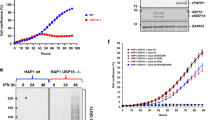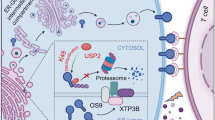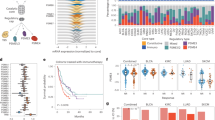Abstract
Recognition and elimination of malignant cells by cytotoxic T lymphocytes depends on antigenic peptides generated by proteasomes. It has been established that impairment of the immunoproteasome subunits, that is, PSMB8, PSMB9 and PSMB10 (PSMBs), is critical for malignant cells to escape immune recognition. We report here the regulatory mechanism of the repression of PU.1-dependent activation of PSMBs by PML/RARα in the pathogenesis of acute promyelocytic leukemia (APL) and the unidentified function of all-trans retinoic acid (ATRA) as an immunomodulator in the treatment of APL. Chromatin immunoprecipitation and luciferase reporter assays showed that PU.1 directly bound to and coordinately transactivated the promoters of PSMBs, indicating that PSMBs were transcriptional targets of PU.1 and PU.1 regulated their basal expression. Analysis of expression profiling data from a large population of acute myeloid leukemia (AML) patients revealed that the expression levels of PSMBs were significantly lower in APL patients than in non-APL AML patients. Further evidence demonstrated that the decrease in their expression was achieved through PML/RARα-mediated repression of both PU.1-dependent transactivation and PU.1 expression. Moreover, ATRA but not arsenic trioxide induced the expression of PSMBs in APL cells, indicating that ATRA treatment might activate the antigen-processing/presentation machinery. Finally, the above observations were confirmed in primary APL samples. Collectively, our data demonstrate that PML/RARα suppresses PU.1-dependent activation of the immunosubunits, which may facilitate the escape of APL cells from immune surveillance in leukemia development, and ATRA treatment is able to reactivate their expression, which would promote more efficient T-cell-mediated recognition in the treatment.
This is a preview of subscription content, access via your institution
Access options
Subscribe to this journal
Receive 50 print issues and online access
$259.00 per year
only $5.18 per issue
Buy this article
- Purchase on Springer Link
- Instant access to full article PDF
Prices may be subject to local taxes which are calculated during checkout






Similar content being viewed by others
References
Rousselot P, Hardas B, Patel A, Guidez F, Gaken J, Castaigne S et al. The PML-RAR alpha gene product of the t(15;17) translocation inhibits retinoic acid-induced granulocytic differentiation and mediated transactivation in human myeloid cells. Oncogene 1994; 9: 545–551.
Grignani F, Ferrucci PF, Testa U, Talamo G, Fagioli M, Alcalay M et al. The acute promyelocytic leukemia-specific PML-RAR alpha fusion protein inhibits differentiation and promotes survival of myeloid precursor cells. Cell 1993; 74: 423–431.
Grignani F, De Matteis S, Nervi C, Tomassoni L, Gelmetti V, Cioce M et al. Fusion proteins of the retinoic acid receptor-alpha recruit histone deacetylase in promyelocytic leukaemia. Nature 1998; 391: 815–818.
Lin RJ, Sternsdorf T, Tini M, Evans RM . Transcriptional regulation in acute promyelocytic leukemia. Oncogene 2001; 20: 7204–7215.
Hu J, Liu YF, Wu CF, Xu F, Shen ZX, Zhu YM et al. Long-term efficacy and safety of all-trans retinoic acid/arsenic trioxide-based therapy in newly diagnosed acute promyelocytic leukemia. Proc Natl Acad Sci USA 2009; 106: 3342–3347.
Wang ZY, Chen Z . Acute promyelocytic leukemia: from highly fatal to highly curable. Blood 2008; 111: 2505–2515.
Zheng PZ, Wang KK, Zhang QY, Huang QH, Du YZ, Zhang QH et al. Systems analysis of transcriptome and proteome in retinoic acid/arsenic trioxide-induced cell differentiation/apoptosis of promyelocytic leukemia. Proc Natl Acad Sci USA 2005; 102: 7653–7658.
Doucas V, Brockes JP, Yaniv M, de The H, Dejean A . The PML-retinoic acid receptor alpha translocation converts the receptor from an inhibitor to a retinoic acid-dependent activator of transcription factor AP-1. Proc Natl Acad Sci USA 1993; 90: 9345–9349.
Wang K, Wang P, Shi J, Zhu X, He M, Jia X et al. PML/RARalpha targets promoter regions containing PU.1 consensus and RARE half sites in acute promyelocytic leukemia. Cancer Cell 2010; 17: 186–197.
Tsuzuki S, Towatari M, Saito H, Enver T . Potentiation of GATA-2 activity through interactions with the promyelocytic leukemia protein (PML) and the t(15;17)-generated PML-retinoic acid receptor alpha oncoprotein. Mol Cell Biol 2000; 20: 6276–6286.
Jansen JH, Mahfoudi A, Rambaud S, Lavau C, Wahli W, Dejean A . Multimeric complexes of the PML-retinoic acid receptor alpha fusion protein in acute promyelocytic leukemia cells and interference with retinoid and peroxisome-proliferator signaling pathways. Proc Natl Acad Sci USA 1995; 92: 7401–7405.
Hoemme C, Peerzada A, Behre G, Wang Y, McClelland M, Nieselt K et al. Chromatin modifications induced by PML-RARalpha repress critical targets in leukemogenesis as analyzed by ChIP–Chip. Blood 2008; 111: 2887–2895.
Aptsiauri N, Cabrera T, Garcia-Lora A, Lopez-Nevot MA, Ruiz-Cabello F, Garrido F . MHC class I antigens and immune surveillance in transformed cells. Int Rev Cytol 2007; 256: 139–189.
Goldberg AL, Gaczynska M, Grant E, Michalek M, Rock KL . Functions of the proteasome in antigen presentation. Cold Spring Harb Symp Quant Biol 1995; 60: 479–490.
Rock KL, Goldberg AL . Degradation of cell proteins and the generation of MHC class I-presented peptides. Annu Rev Immunol 1999; 17: 739–779.
Seliger B, Maeurer MJ, Ferrone S . Antigen-processing machinery breakdown and tumor growth. Immunol Today 2000; 21: 455–464.
Zheng P, Guo Y, Niu Q, Levy DE, Dyck JA, Lu S et al. Proto-oncogene PML controls genes devoted to MHC class I antigen presentation. Nature 1998; 396: 373–376.
Promsuwicha O, Auewarakul CU . Positive and negative predictive values of HLA-DR and CD34 in the diagnosis of acute promyelocytic leukemia and other types of acute myeloid leukemia with recurrent chromosomal translocations. Asian Pac J Allergy Immunol 2009; 27: 209–216.
Vertuani S, De Geer A, Levitsky V, Kogner P, Kiessling R, Levitskaya J . Retinoids act as multistep modulators of the major histocompatibility class I presentation pathway and sensitize neuroblastomas to cytotoxic lymphocytes. Cancer Res 2003; 63: 8006–8013.
Padua RA, Larghero J, Robin M, le Pogam C, Schlageter MH, Muszlak S et al. PML-RARA-targeted DNA vaccine induces protective immunity in a mouse model of leukemia. Nat Med 2003; 9: 1413–1417.
Robin M, Andreu-Gallien J, Schlageter MH, Bengoufa D, Guillemot I, Pokorna K et al. Frequent antibody production against RARalpha in both APL mice and patients. Blood 2006; 108: 1972–1974.
Zhu X, Zhang H, Qian M, Zhao X, Yang W, Wang P et al. The significance of low PU.1 expression in patients with acute promyelocytic leukemia. J Hematol Oncol 2012; 5: 22.
Wouters BJ, Lowenberg B, Erpelinck-Verschueren CA, van Putten WL, Valk PJ, Delwel R . Double CEBPA mutations, but not single CEBPA mutations, define a subgroup of acute myeloid leukemia with a distinctive gene expression profile that is uniquely associated with a favorable outcome. Blood 2009; 113: 3088–3091.
Ross ME, Mahfouz R, Onciu M, Liu HC, Zhou X, Song G et al. Gene expression profiling of pediatric acute myelogenous leukemia. Blood 2004; 104: 3679–3687.
Tomasson MH, Xiang Z, Walgren R, Zhao Y, Kasai Y, Miner T et al. Somatic mutations and germline sequence variants in the expressed tyrosine kinase genes of patients with de novo acute myeloid leukemia. Blood 2008; 111: 4797–4808.
Hallermalm K, Seki K, Wei C, Castelli C, Rivoltini L, Kiessling R et al. Tumor necrosis factor-alpha induces coordinated changes in major histocompatibility class I presentation pathway, resulting in increased stability of class I complexes at the cell surface. Blood 2001; 98: 1108–1115.
Olive V, Wagner N, Chan S, Kastner P, Vannetti C, Cuzin F et al. PU.1 (Sfpi1), a pleiotropic regulator expressed from the first embryonic stages with a crucial function in germinal progenitors. Development 2007; 134: 3815–3825.
Singh H . PU.1, a shared transcriptional regulator of innate and adaptive immune cell fates. J Immunol 2008; 181: 1595–1596.
Carotta S, Wu L, Nutt SL . Surprising new roles for PU.1 in the adaptive immune response. Immunol Rev 2010; 238: 63–75.
Spain LM, Guerriero A, Kunjibettu S, Scott EW . T cell development in PU.1-deficient mice. J Immunol 1999; 163: 2681–2687.
Lloberas J, Soler C, Celada A . The key role of PU.1/SPI-1 in B cells, myeloid cells and macrophages. Immunol Today 1999; 20: 184–189.
Carotta S, Dakic A, D’Amico A, Pang SH, Greig KT, Nutt SL et al. The transcription factor PU.1 controls dendritic cell development and Flt3 cytokine receptor expression in a dose-dependent manner. Immunity 2010; 32: 628–641.
Kanada S, Nishiyama C, Nakano N, Suzuki R, Maeda K, Hara M et al. Critical role of transcription factor PU.1 in the expression of CD80 and CD86 on dendritic cells. Blood 2011; 117: 2211–2222.
Smith-Garvin JE, Koretzky GA, Jordan MS . T cell activation. Annu Rev Immunol 2009; 27: 591–619.
Lecchi M, Lovisone E, Genetta C, Peruccio D, Resegotti L, Richiardi P . Gamma-IFN induces a differential expression of HLA-DR, DQ and DP antigens on peripheral blood myeloid leukemic blasts at various stages of differentiation. Leuk Res 1989; 13: 221–226.
Jinnai I . In vitro growth response to G-CSF and GM-CSF by bone marrow cells of patients with acute myeloid leukemia. Leuk Res 1990; 14: 227–240.
Larsen F, Solheim J, Kristensen T, Kolsto AB, Prydz H . A tight cluster of five unrelated human genes on chromosome 16q22.1. Hum Mol Genet 1993; 2: 1589–1595.
Lowenberg B, Griffin JD, Tallman MS . Acute myeloid leukemia and acute promyelocytic leukemia. Hematol Am Soc Hematol Educ Program 2003. 82–101.
Zhang Y, Zhang Z, Li J, Li L, Han X, Han L et al. Long-term efficacy and safety of arsenic trioxide for first-line treatment of elderly patients with newly diagnosed acute promyelocytic leukemia. Cancer 2013; 119: 115–125.
Shen ZX, Shi ZZ, Fang J, Gu BW, Li JM, Zhu YM et al. All-trans retinoic acid/As2O3 combination yields a high quality remission and survival in newly diagnosed acute promyelocytic leukemia. Proc Natl Acad Sci USA 2004; 101: 5328–5335.
Zheng X, Seshire A, Ruster B, Bug G, Beissert T, Puccetti E et al. Arsenic but not all-trans retinoic acid overcomes the aberrant stem cell capacity of PML/RARalpha-positive leukemic stem cells. Haematologica 2007; 92: 323–331.
Huang ME, Ye YC, Chen SR, Chai JR, Lu JX, Zhoa L et al. Use of all-trans retinoic acid in the treatment of acute promyelocytic leukemia. Blood 1988; 72: 567–572.
Idres N, Benoit G, Flexor MA, Lanotte M, Chabot GG . Granulocytic differentiation of human NB4 promyelocytic leukemia cells induced by all-trans retinoic acid metabolites. Cancer Res 2001; 61: 700–705.
Maeda Y, Horiuchi F, Miyatake J, Sono H, Tatsumi Y, Urase F et al. Inhibition of growth and induction of apoptosis by all-trans retinoic acid in lymphoid cell lines transfected with the PML/RAR alpha fusion gene. Br J Haematol 1996; 93: 973–976.
Collins SJ . Retinoic acid receptors, hematopoiesis and leukemogenesis. Curr Opin Hematol 2008; 15: 346–351.
Schlenk RF, Frohling S, Hartmann F, Fischer JT, Glasmacher A, del Valle F et al. Phase III study of all-trans retinoic acid in previously untreated patients 61 years or older with acute myeloid leukemia. Leukemia 2004; 18: 1798–1803.
Hu ZB, Minden MD, McCulloch EA . Phosphorylation of BCL-2 after exposure of human leukemic cells to retinoic acid. Blood 1998; 92: 1768–1775.
Carter BZ, Milella M, Altieri DC, Andreeff M . Cytokine-regulated expression of survivin in myeloid leukemia. Blood 2001; 97: 2784–2790.
Meijerink J, Mandigers C, van de Locht L, Tonnissen E, Goodsaid F, Raemaekers J . A novel method to compensate for different amplification efficiencies between patient DNA samples in quantitative real-time PCR. J Mol Diagn 2001; 3: 55–61.
Nigten J, Breems-de Ridder MC, Erpelinck-Verschueren CA, Nikoloski G, van der Reijden BA, van Wageningen S et al. ID1 and ID2 are retinoic acid responsive genes and induce a G0/G1 accumulation in acute promyelocytic leukemia cells. Leukemia 2005; 19: 799–805.
Zou D, Yang X, Tan Y, Wang P, Zhu X, Yang W et al. Regulation of the hematopoietic cell kinase (HCK) by PML/RARalpha and PU.1 in acute promyelocytic leukemia. Leuk Res 2012; 36: 219–223.
Carroll JS, Liu XS, Brodsky AS, Li W, Meyer CA, Szary AJ et al. Chromosome-wide mapping of estrogen receptor binding reveals long-range regulation requiring the forkhead protein FoxA1. Cell 2005; 122: 33–43.
Acknowledgements
This work was supported, in part, by Ministry of Science and Technology Grants of China (2009CB825607, 2012AA02A211 and 2011CB910202) and National Natural Science Foundation Grants of China (31171257, 81270625 and 31100942).
Author contributions
XY performed experiments, analyzed data and wrote the manuscript; PW and JL performed experiments; HZ, WX and JX analyzed data; KW designed the research, interpreted data and wrote the manuscript.
Author information
Authors and Affiliations
Corresponding author
Ethics declarations
Competing interests
The authors declare no conflict of interest.
Additional information
Supplementary Information accompanies this paper on the Oncogene website
Supplementary information
Rights and permissions
About this article
Cite this article
Yang, XW., Wang, P., Liu, JQ. et al. Coordinated regulation of the immunoproteasome subunits by PML/RARα and PU.1 in acute promyelocytic leukemia. Oncogene 33, 2700–2708 (2014). https://doi.org/10.1038/onc.2013.224
Received:
Revised:
Accepted:
Published:
Issue Date:
DOI: https://doi.org/10.1038/onc.2013.224
Keywords
This article is cited by
-
Anti-tumor activity of all-trans retinoic acid in gastric-cancer: gene-networks and molecular mechanisms
Journal of Experimental & Clinical Cancer Research (2023)
-
Chromatin topology reorganization and transcription repression by PML-RARα in acute promyeloid leukemia
Genome Biology (2020)
-
Proteasome dysregulation in human cancer: implications for clinical therapies
Cancer and Metastasis Reviews (2017)



